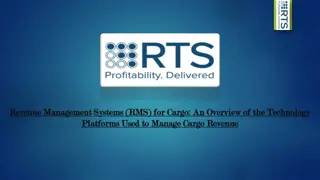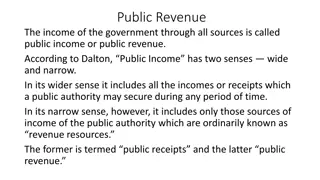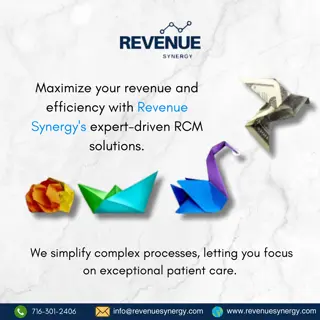Boost Revenue with ML Recommendation Systems
Recommendation engines are essential tools that analyze user data to predict their interests, driving engagement, satisfaction, and revenue. MoogleLabs offers innovative AI/ML, Blockchain, DevOps, and Data Science solutions to transform businesses. Learn about content-based and collaborative filtering recommendation engines and their industrial applications. Discover how companies like Netflix and Amazon leverage recommendation systems to multiply their revenue. Explore the impact of recommendation engines on job portals and e-commerce platforms. Partner with MoogleLabs to unlock hidden revenue opportunities and enhance business performance.
Download Presentation

Please find below an Image/Link to download the presentation.
The content on the website is provided AS IS for your information and personal use only. It may not be sold, licensed, or shared on other websites without obtaining consent from the author.If you encounter any issues during the download, it is possible that the publisher has removed the file from their server.
You are allowed to download the files provided on this website for personal or commercial use, subject to the condition that they are used lawfully. All files are the property of their respective owners.
The content on the website is provided AS IS for your information and personal use only. It may not be sold, licensed, or shared on other websites without obtaining consent from the author.
E N D
Presentation Transcript
ML RECOMMENDATION SYSTEM INCREASE REVENUE MULTI- FOLD WITH THE RIGHT TOOLS ATIREK GUPTA| ML ENGINEER NIKHIL SHARMA | ML ENGINEER
MOOGLELABS - SERVICES Decoding Innovation In AI/ML, Blockchain, DevOps, Metaverse and Data Science Many organizations are afraid to take the leap toward AI/ML, Blockchain, DevOps, and Data Science. MoogleLabs makes the journey streamlined and smooth for you. Founded by seasoned IT experts, the company has the resources to help your business embrace new-age technology. At MoogleLabs, we help you compete effectively by leveraging cutting-edge technology and in this endeavor, we have a talented team, which is certified in the technologies it works on. We have transformed businesses with our deep understanding of technology that can be utilized for various industries. The company is known for building a great client-business relationship by being transparent throughout the whole journey. MoogleLabs is always ready to better itself to provide the best services to its clients. Artificial Intelligence Machine Learning Data Science Blockchain DevOps Uncover hidden stories in data and turn it into maximized revenue opportunities using qualitative and quantitative data processing techniques. We specialize in DevOps managed services including CI/CD, Infrastructure Management, Cloud Managed Services, DevSecOps, and AI Ops. We help you build a secured decentralized solution for Smart Contracts, Crypto-token and NFT Marketplace. Our Applied AI brings roadmap to scale enterprise-grade solutions, with the power of analytics, automation and next-level computing. Scale up your business with future-ready ML-powered applications integrated with AR/VR, image & video analytics.
OVERVIEW OVERVIEW What is recommendation engine? Types of recommendation engine Collaborative Filtering Content based filtering Hybrid Filtering Industrial Application How Companies like Netflix ,Amazon, Meta & Big Basket multiple there revenue using recommendation engine. Implementation By MoogleLabs a. How recommendation engine is improving Job portals b. How recommendation engine increase sales of E- commerce platform
WHAT IS RECOMMENDATION ENGINE? A recommendation engine is a software tool that analyzes user data to make predictions about what users are likely to be interested in. These predictions are based on a combination of factors, including user behavior, demographic information, and past interactions with the platform. Recommendation engines are widely used in e-commerce, social media, and content platforms to improve user engagement, satisfaction, and revenue. They help users discover new products, services, or content that they are likely to be interested in, based on their previous interactions with the platform or similar users.
Content-based recommendation engines: These recommend items to users based on their similarity to previously liked or viewed items. For example, if a user has watched several science fiction movies, a content- based engine may recommend other science fiction movies.
Advantages of Content Based Filtering Personalization: Content-based recommenders are good at recommending items to users based on their past behavior or preferences. They recommend items that are similar to what users have previously shown interest in, and this increases the likelihood of users engaging with the recommended content. Disadvantages of Content Based Filtering Since the feature representation of the items are hand-engineered to some extent, this technique requires a lot of domain knowledge. Therefore, the model can only be as good as the hand-engineered features.
Collaborative filtering recommendation engines: These recommend items to users based on the preferences of similar users. For example, if two users have similar viewing histories, a collaborative filtering engine may recommend items that one user has watched and the other has not.
Advantages of collaborative filtering: Not required to understand item content: The content of the items does not necessarily tell the whole story, such as movie type/genre, and so on. No item cold-start problem: Even when no information on an item is available, we still can predict the item rating without waiting for a user to purchase it. Captures the change in user interests over time: Focusing solely on content does not provide any flexibility on the user's perspective and their preferences. Disadvantages of Collaborative Filtering: cold-start problem : The cold start problem that describes the difficulty of CF making recommendations when the users or the products are new. Scalability: Traditional CF algorithms often suffer serious scalability problems. As the number of users increases and the amount of data expands, collaborative algorithms will begin to suffer a decrease in performances simply due to the sheer increase in data volume.
Hybrid recommendation engines: These combine multiple recommendation techniques to provide more accurate and diverse recommendations. For example, a hybrid engine may use both content-based and collaborative filtering techniques to recommend items.
Advantages of Hybrid filtering: 1.Improved recommendation accuracy: By combining multiple recommendation techniques, hybrid systems can provide more accurate recommendations to users. 2.Overcoming the cold start problem 3.Handling of sparsity: Collaborative filtering can suffer from sparsity issues, where there may not be enough data to make accurate recommendations for some users or items. A hybrid approach can use content-based filtering to provide recommendations in these cases. Disadvantages of Hybrid filtering: Complexity Maintenance Data integration Cold-start problem: Hybrid recommendation systems can still suffer from the cold-start problem, which occurs when there is not enough user or item data available to make accurate recommendations. This can be especially challenging for new products or services.
INDUSTRIAL APPLICATIONS HOW COMPANIES LIKE NETFLIX, META, NAUKRI.COM & BIG BASKET MULTIPLE THERE REVENUE USING RECOMMENDATION ENGINE
So taking an example of METAs favorite product Instagram. The way it works is suppose a content creator has uploaded a reel on Instagram now the reel is being analyzed by a vision AI software and an NLP AI software the work of both the software s is to analyze the content and find target audience for it. Once the target audience is defined then then reel is pushed to a segment of that target audience and the user s behavior is collected to be feed as an input to the recommendation engine. Here the recommendation engine is a Hybrid Recommendation Engine as the content need to be recommended based on both collaborative filtering( Similar Users ) and content based filtering( Similar Content viewers ). This whole process tends to increase more retention time of the user so the user is now spending more time than usual so more advertisements are being displayed on the users feed via which Instagram earns revenue and charge companies for advertisement.























